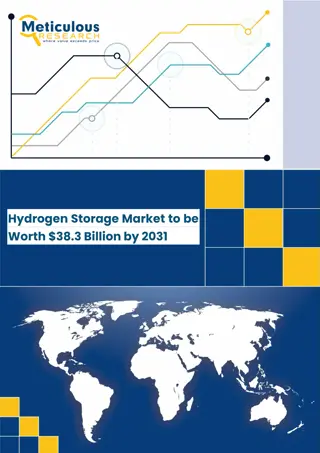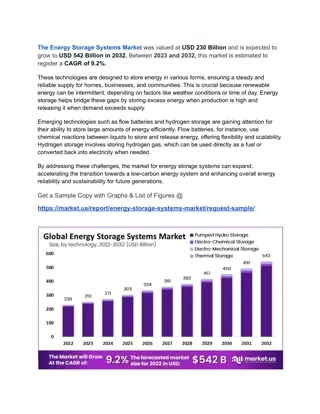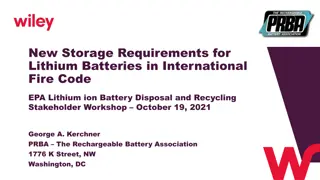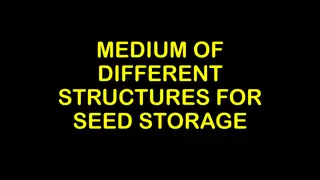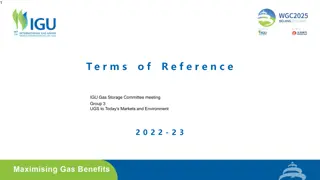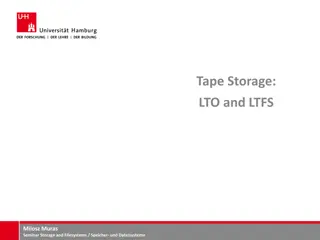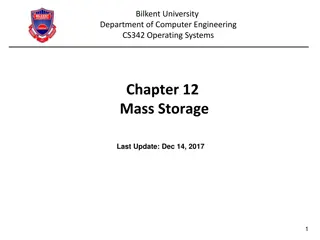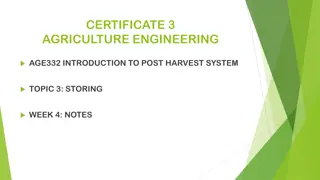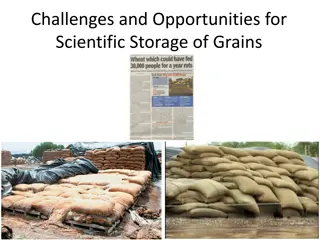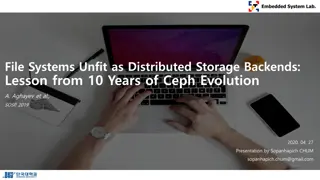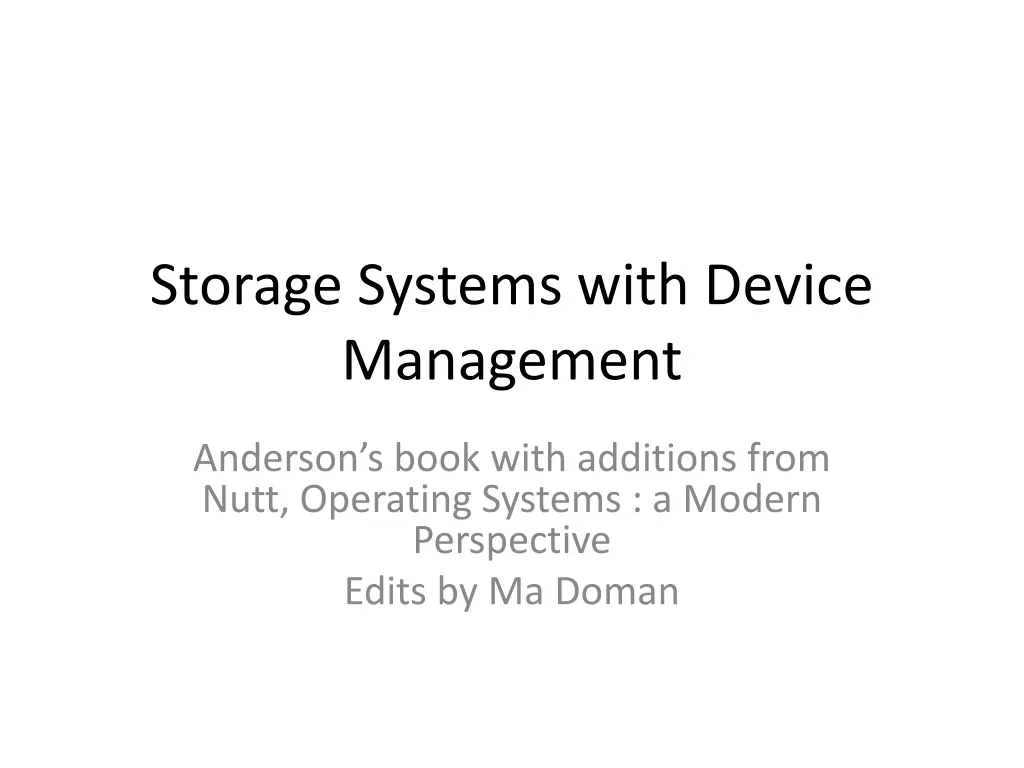
Modern Perspective on Device Management in Storage Systems
Explore the intricacies of device management in storage systems through the lens of modern perspectives. Dive into concepts like file systems, disk characteristics, and I/O devices. Gain insights into device interfaces, organization, and system call interfaces, all from the perspective of operating systems.
Uploaded on | 2 Views
Download Presentation

Please find below an Image/Link to download the presentation.
The content on the website is provided AS IS for your information and personal use only. It may not be sold, licensed, or shared on other websites without obtaining consent from the author. If you encounter any issues during the download, it is possible that the publisher has removed the file from their server.
You are allowed to download the files provided on this website for personal or commercial use, subject to the condition that they are used lawfully. All files are the property of their respective owners.
The content on the website is provided AS IS for your information and personal use only. It may not be sold, licensed, or shared on other websites without obtaining consent from the author.
E N D
Presentation Transcript
Storage Systems with Device Management Anderson s book with additions from Nutt, Operating Systems : a Modern Perspective Edits by Ma Doman
Main Points Device Management Overview File systems devices in particular Useful abstractions on top of physical devices Storage hardware characteristics Disks and flash memory File system usage patterns
Input/Output Devices Output Device Processor Input Device Operating Systems: A Modern Perspective, Chapter 5
The Device Driver Interface write( ); Device Interface Terminal Driver Printer Driver Disk Driver Terminal Controller Printer Controller Disk Controller Operating Systems: A Modern Perspective, Chapter 5
Device Management Organization Application Process System Interface File Manager Device-Independent Device-Dependent Hardware Interface Command Status Data Device Controller Operating Systems: A Modern Perspective, Chapter 5
System Call Interface Functions available to application programs Abstract all devices (and files) to a few interfaces Make interfaces as similar as possible Block vs character Sequential vs direct access Device driver implements functions (one entry point per API function) Operating Systems: A Modern Perspective, Chapter 5
Example: UNIX Driver Interfacing functions between user space and kernel space Events User functions Kernel functions Load module insmod module_init() Open device fopen file_operations: open Close device fread file_operations: read Write device fwrite file_operations: write Close device fclose file_operations: release Remove module rmmod module_exit() Interfacing functions between kernel space and the hardware device Events Kernel functions Read data inb Write data outb Operating Systems: A Modern Perspective, Chapter 5
Overlapping the Operation of a Device and the CPU . . . startRead(dev_I, %d , x); . . . While(stillReading()) ; y = f(x) . . . . . . read(dev_I, %d , x); y = f(x) . . . Data on device Variable x Register Device dev_I Memory CPU Operating Systems: A Modern Perspective, Chapter 5
Overlapping Processing and I/O App 1 App 2 I/O Ctlr t1 t2 t3 t4 Operating Systems: A Modern Perspective, Chapter 5
Driver-Kernel Interface Drivers are distinct from main part of kernel Kernel makes calls on specific functions, drivers implement them Drivers use kernel functions for: Device allocation Resource (e.g., memory) allocation Scheduling etc. (varies from OS to OS) Operating Systems: A Modern Perspective, Chapter 5
Reconfigurable Device Drivers System call interface open(){ } read(){ } Entry Points for Device j etc. Other Kernel services Driver for Device j Operating Systems: A Modern Perspective, Chapter 5
Hardware Buffering Process Process Process Controller Controller Controller Data A B A B Device Device Device Process reads bi-1 Controller reads bi Process reads bi Controller reads bi+1 Unbuffered Operating Systems: A Modern Perspective, Chapter 5
Double Buffering in the Driver Process Process A B A B Driver Controller Controller A B A B Hardware Device Device Operating Systems: A Modern Perspective, Chapter 5
Circular Buffering To data consumer Buffer i Buffer j From data producer Operating Systems: A Modern Perspective, Chapter 5
A Generic Communications Device Bus Generic Controller Communications Controller Local Device Cabling connecting the controller to the device Device Printer Modem Network Operating Systems: A Modern Perspective, Chapter 5
Rotating Media Cylinder (set of tracks) Track (Cylinder) (a) Multi-surface Disk (b) Disk Surface (b) Cylinders Operating Systems: A Modern Perspective, Chapter 5
File Systems Abstraction on top of persistent storage Magnetic disk Flash memory (e.g., USB thumb drive) Devices provide Storage that (usually) survives across machine crashes Block level (random) access Large capacity at low cost Relatively slow performance Magnetic disk read takes 10-20M processor instructions
File System as Illusionist: Hide Limitations of Physical Storage Persistence of data stored in file system: Even if crash happens during an update Even if disk block becomes corrupted Even if flash memory wears out Naming: Named data instead of disk block numbers Directories instead of flat storage Byte addressable data even though devices are block- oriented Performance: Cached data Data placement and data structure organization Controlled access to shared data
File System Abstraction File system Persistent, named data Hierarchical organization (directories, subdirectories) Access control on data File: named collection of data Linear sequence of bytes (or a set of sequences) Read/write or memory mapped Crash and storage error tolerance Operating system crashes (and disk errors) leave file system in a valid state Performance Achieve close to the hardware limit in the average case
File System Abstraction Directory Group of named files or subdirectories Mapping from file name to file metadata location Path String that uniquely identifies file or directory Ex: /cse/www/education/courses/cse451/12au Links Hard link: link from name to metadata location Soft link: link from name to alternate name Mount Mapping from name in one file system to root of another
UNIX File System API create, link, unlink, createdir, rmdir Create file, link to file, remove link Create directory, remove directory open, close, read, write, seek Open/close a file for reading/writing Seek resets current position fsync File modifications can be cached fsync forces modifications to disk (like a memory barrier)
File System Interface UNIX file open is a Swiss Army knife: Open the file, return file descriptor Options: if file doesn t exist, return an error If file doesn t exist, create file and open it If file does exist, return an error If file does exist, open file If file exists but isn t empty, nix it then open If file exists but isn t empty, return an error
Interface Design Question Why not separate syscalls for open/create/exists? Would be more modular! if (!exists(name)) create(name); // can create fail? fd = open(name); // does the file exist?
Storage Devices Magnetic disks Storage that rarely becomes corrupted Large capacity at low cost Block level random access Slow performance for random access Better performance for streaming access Flash memory Storage that rarely becomes corrupted Capacity at intermediate cost (50x disk) Block level random access Good performance for reads; worse for random writes
Disk Tracks ~ 1 micron wide Wavelength of light is ~ 0.5 micron Resolution of human eye: 50 microns 100K on a typical 2.5 disk Separated by unused guard regions Reduces likelihood neighboring tracks are corrupted during writes (still a small non-zero chance) Track length varies across disk Outside: More sectors per track, higher bandwidth Disk is organized into regions of tracks with same # of sectors/track Only outer half of radius is used Most of the disk area in the outer regions of the disk
Sectors Sectors contain sophisticated error correcting codes Disk head magnet has a field wider than track Hide corruptions due to neighboring track writes Sector sparing Remap bad sectors transparently to spare sectors on the same surface Slip sparing Remap all sectors (when there is a bad sector) to preserve sequential behavior Track skewing Sector numbers offset from one track to the next, to allow for disk head movement for sequential ops
Disk Performance Disk Latency = Seek Time + Rotation Time + Transfer Time Seek Time: time to move disk arm over track (1-20ms) Fine-grained position adjustment necessary for head to settle Head switch time ~ track switch time (on modern disks) Rotation Time: time to wait for disk to rotate under disk head Disk rotation: 4 15ms (depending on price of disk) Transfer Time: time to transfer data onto/off of disk Disk head transfer rate: 50-100MB/s (5-10 usec/sector) Host transfer rate dependent on I/O connector (USB, SATA, )
Question How long to complete 500 random disk reads, in FIFO order?
Question How long to complete 500 random disk reads, in FIFO order? Seek: average 10.5 msec Rotation: average 4.15 msec Transfer: 5-10 usec 500 * (10.5 + 4.15 + 0.01)/1000 = 7.3 seconds
Question How long to complete 500 sequential disk reads?
Question How long to complete 500 sequential disk reads? Seek Time: 10.5 ms (to reach first sector) Rotation Time: 4.15 ms (to reach first sector) Transfer Time: (outer track) 500 sectors * 512 bytes / 128MB/sec = 2ms Total: 10.5 + 4.15 + 2 = 16.7 ms Might need an extra head or track switch (+1ms) Track buffer may allow some sectors to be read off disk out of order (-2ms)
Question How large a transfer is needed to achieve 80% of the max disk transfer rate?
Question How large a transfer is needed to achieve 80% of the max disk transfer rate? Assume x rotations are needed, then solve for x: 0.8 (10.5 ms + (1ms + 8.4ms) x) = 8.4ms x Total: x = 9.1 rotations, 9.8MB
Disk Optimizations Transfer Time: Time to copy bits from disk surface to memory Disk latency time: Rotational delay waiting for proper sector to rotate under R/W head Disk seek time: Delay while R/W head moves to the destination track/cylinder Access Time = seek + latency + transfer Operating Systems: A Modern Perspective, Chapter 5
Optimizing Seek Time Multiprogramming on I/O-bound programs => set of processes waiting for disk Seek time dominates access time => minimize seek time across the set Tracks 0:99; Head at track 75, requests for 23, 87, 36, 93, 66 FCFS: 52+ 64 + 51 + 57 + 27 = 251 steps Operating Systems: A Modern Perspective, Chapter 5
Optimizing Seek Time (cont) Requests = 23, 87, 36, 93, 66 SSTF: (75), 66, 87, 93, 36, 23 11 + 21 + 6 + 57 + 13 = 107 steps Scan: (75), 87, 93, 99, 66, 36, 23 12 + 6 + 6 + 33 + 30 + 13 = 100 steps Look: (75), 87, 93, 66, 36, 23 12 + 6 + 27 + 30 + 13 = 87 steps Operating Systems: A Modern Perspective, Chapter 5
Optimizing Seek Time (cont) Requests = 23, 87, 36, 93, 66 Circular Scan: (75), 87, 93, 99, 23, 36, 66 12 + 6 + 6 + home + 23 + 13 + 30 = 90 + home Circular Look: (75), 87, 93, 23, 36, 66 12 + 6 + home + 23 + 13 + 30 = 84 + home Operating Systems: A Modern Perspective, Chapter 5
Disk Scheduling FIFO Schedule disk operations in order they arrive Downsides?
Disk Scheduling Shortest seek time first Not optimal! Suppose cluster of requests at far end of disk Downsides?
Disk Scheduling SCAN: move disk arm in one direction, until all requests satisfied, then reverse direction
Disk Scheduling CSCAN: move disk arm in one direction, until all requests satisfied, then start again from farthest request
Disk Scheduling R-CSCAN: CSCAN but take into account that short track switch is < rotational delay
Flash Memory Additional information
Flash Memory Writes must be to clean cells; no update in place Large block erasure required before write Erasure block: 128 512 KB Erasure time: Several milliseconds Write/read page (2-4KB) 50-100 usec
Question Why are random writes so slow? Random write: 2000/sec Random read: 38500/sec
Flash Translation Layer Flash device firmware maps logical page # to a physical location Move live pages as needed for erasure Garbage collect empty erasure block by copying live pages to new location Wear-levelling Can only write each physical page a limited number of times Avoid pages that no longer work Transparent to the device user



